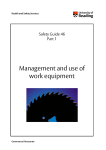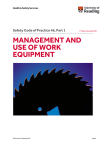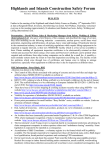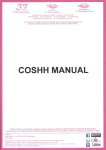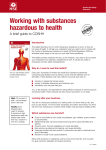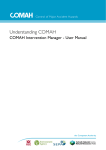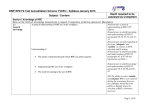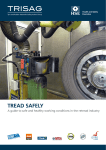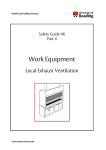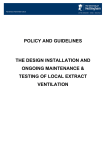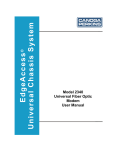Download COSHH essentials for the microelectronics industry MC6
Transcript
Health and Safety Executive Ion implantation MC6 6 COSHH essentials for the microelectronics industry This information will help employers comply with the Control of Substances Hazardous to Health Regulations 2002 (COSHH), as amended, to control exposure and protect workers’ health. It is also useful for trade union and safety representatives. Ion Implantation adds chemical ‘dopants’ to silicon wafers by exposing them to an ion beam. This process takes place within a vacuum system and is contained. Exposure to toxic substances may occur when changing gas supply cylinders, replenishing solid ion source materials, removing and servicing contaminated parts (eg ion source), and during routine maintenance tasks such as removing process residues from affected parts. Control approach 3 Containment and Control approach 2 Engineering control Access and premises ✓ ✓ ✓ ✓ Restrict access to authorised staff. Exclude unprotected staff. Keep the workplace well organised and keep exit routes clear. Label the work area, pipework and equipment clearly. Equipment ✓ ✓ General operation In general, ion implanters used within the microelectronics industry can be represented by the following diagram. Because of the high vacuum required, all routine processes are contained, often with double containment and alarms to warn of any escape from the inner containment. Follow the manufacturer’s specification for extraction criteria. Chemicals and by-products can be flammable, pyrophoric, toxic, very toxic, corrosive or carcinogenic (arsenic). This sheet describes good practice using containment, with extraction, and covers the points you need to follow to reduce exposure to an adequate level. It is important to follow all the points on the sheet, or use equally effective measures. This sheet covers daily and weekly routine tasks of operation and maintenance. It does not cover major maintenance tasks or decommissioning of used equipment. Check the supplier’s material safety data sheet - can you use safer chemicals? Plan and practise what you will do in an emergency. For environmental guidelines see MC0. ✓ ✓ ✓ ✓ ✓ ✓ ✓ ✓ ✓ Get safety data sheets from your suppliers and identify the more dangerous chemicals. Can you use less hazardous products, or eliminate the process? Gas boxes containing hazardous process gases should be extracted, and monitored by gas detection systems. Purge cryogenic pumps and exhaust lines with inert gas. Provide a manometer or pressure gauge to check the extraction is working. Link this to a visual or audible warning alarm. Check that the equipment is correctly locked-off where stipulated in the user manual. Keep extraction ducts short and simple. Avoid long sections of flexible ductwork. Ductwork must be compatible with the chemicals being used. Discharge cleaned, extracted air to a safe place outside, away from windows, doors and air inlets. Microelectronics ✓ ✓ ✓ ✓ MC6 Containment/Engineering Control Gas bottle changes Wear positive-pressure supplied-air respiratory protective equipment (RPE) when changing gas supply cylinders containing toxic and corrosive gases. See sheet R5 - see ‘Further information’. For some gases, impermeable gloves and chemical-protective overalls must be worn. Use less hazardous products where practical, eg sub-atmospheric delivery or low pressure products. Solid source material changes Use an extracted cabinet or booth with an inward air flow of at least 0.5 ms-1. Maintenance, examination and testing of controls ✓ ✓ ✓ ✓ ✓ ✓ ✓ ✓ ✓ ✓ ✓ Maintenance procedures are based on enclosed cabinets (control approach 3) or extraction (control approach 2). Use a written system of work for maintenance and define what personal protective equipment (PPE) you need. Clean and maintain systems according to manufacturers’ procedures and schedules to prevent excessive build-up of phosphorus residue and other hazardous by-products. Use water-based cleaning methods wherever possible. Controls should also be suitable for flammable and pyrophoric substances. Provide an extracted cabinet or booth with a face velocity of at least 0.5 ms-1. Where this is not possible, use local dust, fume or vapour extraction that effectively removes the contaminant. Wear RPE and skin protection unless your risk assessment shows this is not necessary. You need to know the design performance to know if extraction is working properly. The supplier’s literature must give this information. Look for signs of damage every time you use the equipment; repair damage immediately. Regularly check: toxic gas systems and exhaust lines for leaks; toxic gas detection systems; and ■ correct operation of chemical control safety interlocks (eg extraction flow sensors, enclosure door switches, dilution flow switches, toxic gas detectors). Keep records of examinations, tests, and subsequent repairs for at least five years. A competent ventilation engineer should examine the system and test its performance at least once every 14 months (see HSE publication HSG54). Keep records of all examinations and tests for at least five years. Some systems may continuously monitor the performance of the extract system. ■ ■ ✓ ✓ Microelectronics ✓ ✓ ✓ ✓ ✓ MC6 Containment/Engineering Control Removal of phosphorus deposits Whenever possible, remove components for cleaning into an extracted booth which is suitable for toxic materials and approved for this purpose. Use effective local extraction to remove toxic gases in-situ. Dampen with de-ionised (DI) water, then gently wear down using abrasive cleaning pads with light circular movements. Class H vacuum cleaners must be emptied and thoroughly cleaned after every use. Residues must be treated as toxic waste and disposed of in accordance with local regulations. Caution: Never use isopropyl alcohol or hydrogen peroxide. Never use scrapers. ✓ ✓ ✓ ✓ ✓ Removal of arsenic deposits (and other hazardous by-products) Whenever possible, remove components to an extracted booth which is suitable for toxic materials and approved for this purpose. Wear defined RPE when cleaning vacuum chamber components insitu. Unprotected persons should not be present in the immediate area. Use wet scrubbing methods such as abrasive cleaning pads with DI water when cleaning vacuum chamber components in-situ. Use supplemental extraction (eg elephant trunk exhaust/mobile fume hood) approved for the collection of arsenic with a trunk of more than 200 mm in diameter and a flow rate sufficient to provide a capture velocity of more than 0.5ms-1 in the work area. You will need to determine the best flow rate for your site, as operating conditions and extraction systems vary. Dispose of hazardous waste according to approved local procedures. Personal protective equipment (PPE) and respiratory protective equipment (RPE) ✓ ✓ Check safety data sheets and equipment maintenance procedures for recommended PPE and ask your supplier for advice. RPE should only be needed for non-routine, emergency or maintenance purposes (eg gas bottle changes, in-situ cleaning) and should be type-assessed following a risk assessment. RPE must fit and users must be properly trained. See sheet R5 or R6 - see ‘Further information’. Training and supervision ✓ ✓ ✓ ✓ ✓ ✓ ✓ Show workers this sheet and check that they understand it. Tell employees about the hazards of source materials and by-products. Tell workers that arsenic can cause cancer. Tell workers that hydrofluoric acid is corrosive, can be absorbed through the skin, and that prompt treatment is needed for exposure despite delayed onset of symptoms. Workers need specific training for most tasks relating to use, service or maintenance of ion implanters. Ask your equipment supplier for advice on training providers. Check that the procedures for service and maintenance and the rules on personal hygiene are being followed. Microelectronics ✓ ✓ ✓ ✓ ✓ ✓ ✓ MC6 Containment/Engineering Control Supervise contractors. Check that PPE and RPE is being maintained, used and stored correctly. Ensure the health/skin/respiratory surveillance programme is being carried out for everyone that needs it. Check that the first aid arrangements work. If HF Antidote Gel (eg calcium gluconate gel) is provided, then make sure first aiders are trained in its correct use and limitations. Check the proper procedures to control contamination spread are followed. Include managers and supervisors in health and safety training. Additional Guidance ✓ ✓ ✓ ✓ ✓ ✓ ✓ If skin problems appear consult an occupational health professional. You may need air monitoring done to make sure the controls are adequate. See COSHH essentials sheet G409 - see ‘Further information’. Always consider elimination, removal or substitution. Review your risk assessment on a regular basis and when any changes take place. Consider additional specialist support for health surveillance. Ensure that the assessor is competent. See Regulation 6 of the COSHH Regulations. See INDG136(rev3) - see ‘Further information’. For general information on training, PPE, cleaning, housekeeping, maintenance and environmental guidelines, please see sheet MC0. Further information ■ ■ ■ ■ ■ ■ ■ ■ ■ ■ An introduction to local exhaust ventilation HSG37 (Second edition) HSE Books 1993 ISBN 978 0 7176 1001 3 Respiratory protective equipment at work: A practical guide HSG53 (Third edition) HSE Books 2005 ISBN 978 0 7176 2904 6 Maintenance, examination and testing of local exhaust ventilation HSG54 (Second edition) HSE Books 1998 ISBN 978 0 7176 1485 1 Monitoring strategies for toxic substances HSG173 (Second edition) HSE Books 2006 ISBN 978 0 7176 6188 6 General ventilation in the workplace: Guidance for employers HSG202 HSE Books 2000 ISBN 978 0 7176 1793 7 Assessment and management of risk at work from skin exposure HSG205 HSE Books 2001 ISBN 0 7176 1826 9 COSHH a brief guide to the Regulations: What you need to know about the Control of Substances Hazardous to Health Regulations 2002 (COSHH) Leaflet INDG136(rev3) HSE Books 2005 www.hse.gov.uk/pubns/indg136.pdf Working safely with solvents: A guide to safe working practices Leaflet INDG273 HSE Books 1998 (single copy free) www.hse.gov.uk/pubns/indg273.pdf Hydrofluoric acid poisoning: Recommendations on first aid procedures Leaflet INDG307 HSE Books 1999 (single copy free or priced packs of 25 ISBN 978 0 7176 1751 7) www.hse.gov.uk/pubns/indg307.pdf Latex and you Leaflet INDG320 HSE Books 2000 www.hse.gov.uk/pubns/indg320.pdf Microelectronics ■ ■ ■ ■ ■ ■ ■ ■ MC6 Containment/Engineering Control Selecting protective gloves for work with chemicals: Guidance for employers and health and safety specialists Leaflet INDG330 HSE Books 2000 www.hse.gov.uk/pubns/indg330.pdf EH40/2005 Workplace exposure limits: Containing the list of workplace exposure limits for use with the Control of Substances Hazardous to Health Regulations 2002 (as amended) Environmental Hygiene Guidance Note EH40 HSE Books 2005 ISBN 978 0 7176 2977 0 Dangerous substances and explosive atmospheres. Dangerous Substances and Explosive Atmospheres Regulations 2002. Approved Code of Practice and guidance L138 HSE Books 2003 ISBN 978 0 7176 2203 0 Arsenic and you: Arsenic is poisonous are you at risk? MSA8 HSE Books 1996 www.hse.gov.uk/pubns/msa8.pdf Other useful COSHH essentials sheets, available on www.hse.gov.uk/pubns/guidance/index.htm): - G409 Exposure measurement: Air sampling - G300 Containment The COSHH essentials risk assessment on www.coshhessentials.org.uk/ HSE Operational Circular Fit Testing of Respiratory Protective Equipment Facepieces OC 282/28 www.hse.gov.uk/ foi/internalops/index.htm Code of Practice: Safety Features of Chemical Workstations Issue 1 Semiconductor Safety Association (Europe) on behalf of the Microelectronics Semiconductor Manufacturing Joint Working Group 1994 ISBN 978 1 872780 02 3 Web version available at www.plade.com/editorial/code.html Useful links ■ ■ ■ ■ For information about health and safety, or to report inconsistencies or inaccuracies in this guidance, visit www.hse.gov.uk/. You can view HSE guidance online and order priced publications from the website. HSE priced publications are also available from bookshops. Contact the British Occupational Hygiene Society (BOHS) on 01332 298101 or at www.bohs.org for lists of qualified hygienists who can help you. Look in the Yellow Pages under ‘Health and safety consultants’ and ‘Health authorities and services’ for ‘occupational health’. Also see www.nhsplus.nhs.uk. This document is available at: www.hse.gov.uk/pubns/guidance/ and www.hse.gov.uk/coshh/essentials/ Employee checklist Follow employer’s procedures for handling chemicals and disposal of waste. Cooperate with occupational hygiene studies and health surveillance schemes Are the engineering controls and extraction systems working properly? Is the equipment in good condition and working properly? Make sure you know what to do if there is a leak or spill. Make sure you have the right PPE for the job you are doing, that it’s in good condition and that you use and store it properly. Do not use gloves that are punctured, split, cracked or otherwise damaged. If you find a problem, tell your supervisor. Don’t just carry on working. Don’t smoke in the work area. Wash your hands before and after eating, drinking, smoking and using the lavatory. Check your skin regularly for dryness or soreness – tell your supervisor if these appear. This document contains notes on good practice which are not compulsory but which you may find helpful in considering what you need to do. © Crown copyright If you wish to reuse this information visit www.hse.gov.uk/copyright.htm for details. First published 05/08 Published by the Health and Safety Executive 08/11





